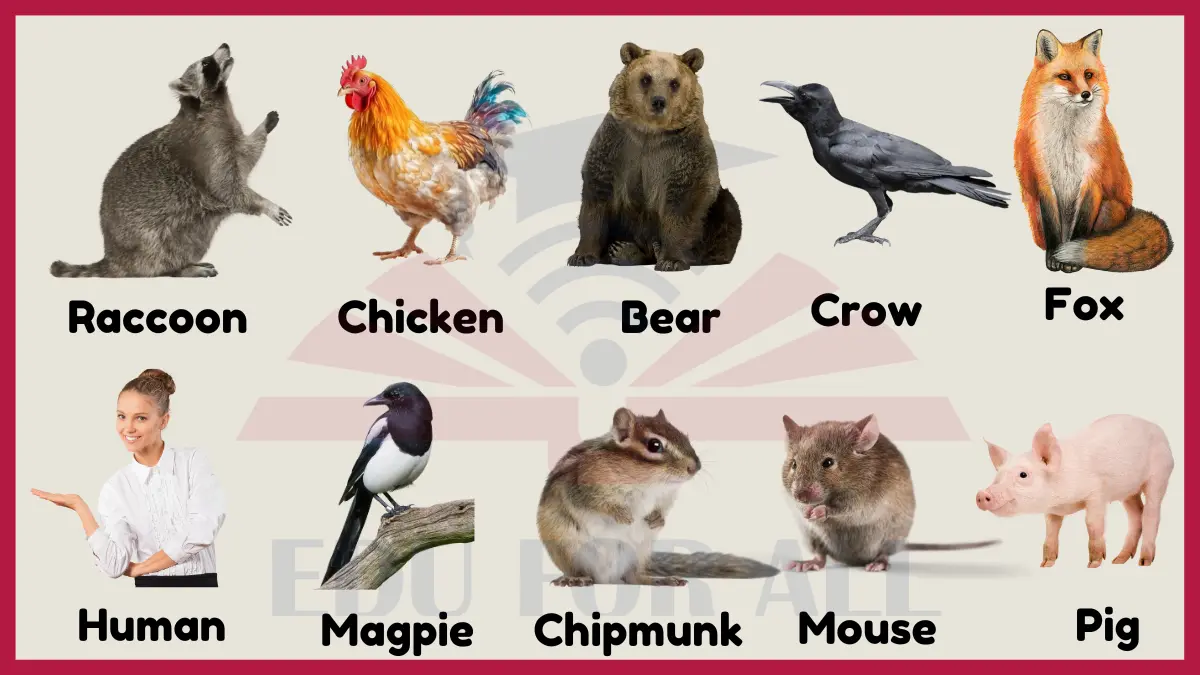Prominent examples of omnivores include bears, which eat berries, insects, fish and sometimes prey animals; chickens, that peck and scratch to consume grains, worms, and insects; crows that use their strong beaks to procure fruits, nuts, snails, eggs and even small vertebrates; raccoons with their dexterous paws that allow them to hunt prey as well as harvest fruits and vegetables; and foxes that use sharp teeth and claws to catch mice or rabbits but also eat berries off shrubs.

Examples of Omnivores
Here are 20 common Examples of Omnivores:
1. Raccoon
Scientific name: Procyon lotor
Diet: Plants, fruits, insects, fish, eggs, small animals
Raccoons have dexterous 5-fingered front paws with a flexible wrist joint that allows them to grasp and manipulate a variety of plant and animal foods, probing holes and opening containers to access fruits, grains, insects, eggs, and aquatic foods as omnivorous feeders.
2. Chicken
Scientific name: Gallus gallus domesticus
Diet: Grains, worms, insects
Chickens employ a pecking, scratching, and digging foraging behavior to seek out worms, insects, seeds, and vegetation on the ground, adaptations which allow them to consume a diverse omnivorous diet.
3. Bear
Scientific name: Ursidae
Diet: Plants, berries, fish, insects, mammals
Bears are equipped with an excellent sense of smell to sniff out varied plant and animal foods, paired with strong limbs, claws for digging, and a varied digestive system as adaptations to an omnivorous diet that includes plants, berries, fish, insects and mammals.
4. Crow
Scientific name: Corvus
Diet: Seeds, fruits, nuts, frogs, snails, worms
Crows use their sturdy beaks to probe soil and decaying wood seeking out insects, nuts, fruits and small animals, versatile behaviors showing their adaptation to an omnivorous and opportunistic diet. Their large brains allow complex social groups and observed tool use.
5. Fox
Scientific name: Vulpes
Diet: Small mammals, fruit, berries, insects
Foxes have a pointed muzzle, sharp teeth, and digestive tract suited for meat alongside berry-filled scat, allowing them to hunt small mammals as well as consume fruits adaptively as omnivores. Foxes use their large ears to hear low scratches of animals moving underground.
6. Pig
Scientific name: Sus scrofa domesticus
Diet: Grains, plants, small animals
Pigs employ snouts, sturdy builds, and rooting behaviors seeking plants, fungi, and small animals underground to procure an omnivorous diet. Despite misconceptions, pigs are highly trainable and known to be cleaner than cats and dogs.
7. Mouse
Scientific name: Mus musculus
Diet: Grains, fruits, insects
Mice evolved as omnivores able to nibble and live near human food storages containing grains, fruits, vegetables, and occasional proteins. Female mice reach reproductive maturity in 6-8 weeks of age, allowing up to 10 litters of 6 young per year.
8. Chipmunk
Scientific name: Tamias
Diet: Acorns, mushrooms, grains, baby birds
Chipmunks utilize sharp teeth to crack hard nuts and burrow underground seeking fungi, seeds, insects, and occasional eggs or nestlings as omnivorous feeders. Their expandable cheek pouches allow transport of up to 8 fruits or nuts for storage.
9. Opossum
Scientific name: Didelphidae
Diet: Insects, frogs, fruits, grains, eggs, carrion
Opossums possess 50 sharp teeth for consuming insects, reptiles, amphibians and carrion, paired with a grip-capable tail and opposable thumbs suited for gathering fruits, nuts, and vegetables as omnivorous foragers. They instinctually “play dead” when threatened.
10. Squirrel
Scientific name: Sciurus
Squirrels employ continually growing incisors to open hard nuts and fruits, nimble limbs for climbing, and stomachs to digest both meat and vegetation as key omnivore adaptations. Squirrels are prolific forgetters yet locate buried nuts and seeds by smell.
11. Magpie
Scientific name: Pica pica
Diet: Grains, berries, ticks, beetles, mammals, carrion
Magpies utilize adaptations like sturdy beaks for cracking into larva and nuts, nimble feet for gathering a wide variety of ground foods, and high intelligence allowing consumption of omnivorous diets plus complex social groups and self-recognition.
12. Human
Scientific name: Homo sapiens
Diet: Plants, animals
Humans employ highly dexterous appendages, diverse digestive systems aided by cooking techniques, and advanced brains allowing the fashioning & use of omnivore-adapting tools like fire, spears, and agriculture.
13. Mongoose
Scientific name: Herpestidae
Diet: Mammals, birds, reptiles, fruits, seeds, insects
Mongooses utilize quick reflexes, thick coats, and immunity boosting proteins to assist hunting reptiles and insects alongside safely gathering fruits, nuts, and eggs as omnivores often in hazardous environments like snake nests. They thrive from rainforests to deserts.
14. Raccoon Dog
Scientific name: Nyctereutes procyonoides
Diet: Amphibians, rodents, fruit, insects, carrion
Raccoon dogs exhibiting sharp claws and teeth, masked faces, thick fur, and rotating ankles allowing them to procure meat and nestling birds alongside fruits, nuts, eggs, and fungi adaptively as omnivores. They are monogamous mate pairers and store fat in the tail.
15. Coyote
Scientific name: Canis latrans
Diet: Mammals, insects, fruit, grass
Coyotes employ swift speeds up to 40 mph, keen eyesight, stealthy paws, rotating ankles, and varied digestive systems to hunt small mammals combined with gathering fruits, vegetables, and insects as highly adaptable omnivores. Alpha coyote pairs mate for life.
16. Brown Bear
Scientific name: Ursus arctos
Diet: Fish, rodents, grains, berries, roots, insects
Brown bears utilize large bodies, sense of smell up to 2 miles away, claw-tipped feet and muscular limbs to catch salmon alongside procuring berries, rodents, roots, grain, and insects as behavioral omnivore feeding adaptations. Most brown bears double their body weight prehibernation.
17. Tanuki
Scientific name: Nyctereutes procyonoides viverrinus
Diet: Small animals, fruit, seeds, insects
Tanukis possess sharp teeth and claws for capturing birds, rodents, reptiles, and insects alongside nimble bodies to climb into orchards and harvest fruits adaptively as omnivores. Their Japanese folklore depictions show them as mischievous, merrymaking shape shifters.
18. Otter
Scientific name: Lutrinae
Diet: Fish, amphibians, mammals, insects, berries
Otters have webbed feet, streamlined bodies, waterproof dense fur, long whiskers, sharp claws and crushing teeth allowing swift swimming to catch fish and harvest riverside plants and fruits as semiaquatic omnivorous foragers. Some use rock tools to break open clams and food caches.
19. Badger
Scientific name: Meles meles
Diet: Earthworms, insects, mammals, amphibians, reptiles, birds, plants
Badgers employ shovel-like claws, muscular front limbs, and wedge-shaped heads to effectively dig into soil seeking worms, insects, reptiles, fungi and roots paired with fruit/nut gathering and limited scavenging as tenacious underground omnivores. Badger groups mark communal territory.
20. Deer
Scientific name: Cervidae
Diet: Birds eggs, fungi, occasionally scavenged meat
As ruminant herbivores, deer possess varied microbiome digestion, yet also occasionally exhibit omnivorous behaviors eating bird eggs, mushrooms, moss, or scavenged meat to supplement minerals and nutrients. Most male deer species regrow elaborate branched antlers annually.

